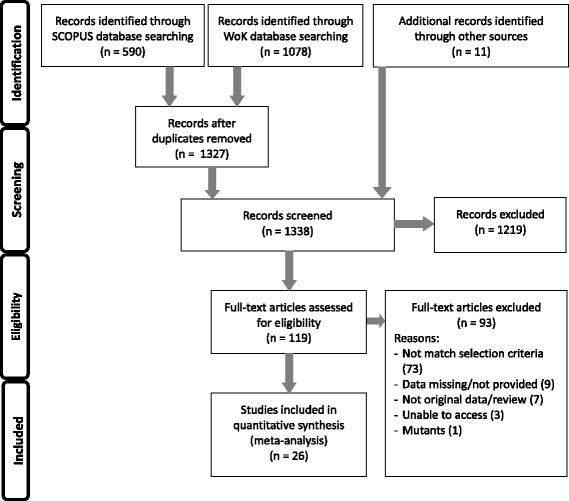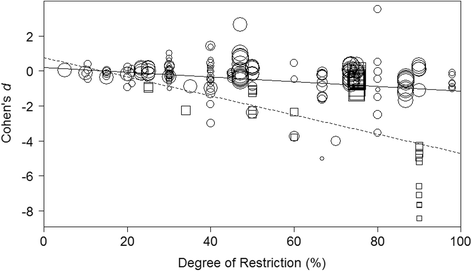The effect of dietary restriction on reproduction: a meta-analytic perspective
- PMID: 27717308
- PMCID: PMC5054627
- DOI: 10.1186/s12862-016-0768-z
The effect of dietary restriction on reproduction: a meta-analytic perspective
Abstract
Background: Dietary restriction (DR), a reduction in the amount of food or particular nutrients eaten, is the most consistent environmental manipulation to extend lifespan and protect against age related diseases. Current evolutionary theory explains this effect as a shift in the resolution of the trade-off between lifespan and reproduction. However, recent studies have questioned the role of reproduction in mediating the effect of DR on longevity and no study has quantitatively investigated the effect of DR on reproduction across species.
Results: Here we report a comprehensive comparative meta-analysis of the effect of DR on reproduction. In general, DR reduced reproduction across taxa, but several factors moderated this effect. The effect of DR on reproduction was greater in well-studied model species (yeast, nematode worms, fruit flies and rodents) than non-model species. This mirrors recent results for longevity and, for reproduction, seems to result from a faster rate of decline with decreasing resources in model species. Our results also suggested that not all reproductive traits are affected equally by DR. High and moderate cost reproductive traits suffered a significant reduction with DR, but low cost traits, such as ejaculate production, did not. Although the effect of DR on reproduction was stronger in females than males, this sex difference reduced to near zero when accounting for other co-factors such as the costliness of the reproductive trait. Thus, sex differences in the effect of DR on longevity may be due to a failure to expose males to as complete a range of the costs of reproduction as females.
Conclusions: We suggest that to better understand the generality of the effect of DR, future studies should attempt to address the cause of the apparent model species bias and ensure that individuals are exposed to as many of the costs of reproduction as possible. Furthermore, our meta-analytic approach reveals a general shortage of DR studies that record reproduction, particularly in males, as well as a lack of direct side-by-side comparisons of the effect of DR on males and females.
Keywords: Breeding; Life history trade-off; Meta-analysis; Nutrition; Systematic review.
Figures



References
-
- Jiang JC, Jaruga E, Repnevskaya MV, Jazwinski SM. An intervention resembling caloric restriction prolongs life span and retards aging in yeast. FASEB J. 2000;14:2135–2137. - PubMed
Publication types
MeSH terms
Associated data
Grants and funding
LinkOut - more resources
Full Text Sources
Other Literature Sources

